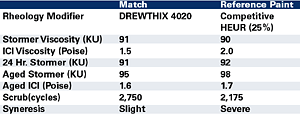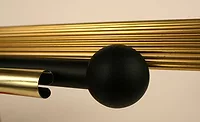High-Performance, Cost-Effective Rheology Modifiers for the Coatings Industry
One class of chemical additives that plays a key role in the development of high-performance coatings is rheology modifiers. Rheology modifiers are essential for application properties, as well as to enhance storage and stability. They can affect processing, color performance and how customers perceive the quality of the paint. Rheology modifiers can thicken or alter the rheology of a coating in a number of ways. Associative and associated thickening mechanisms are the primary ways in which coatings obtain a rheological profile.
The associative mechanism is quite familiar and is caused predominately by hydrophobic portions of thickener molecules interacting and bonding with the surface of latex particles. These interactions are further influenced by surfactants, coalescing solvents and pigments, but are primarily driven by the thickener-latex polymer particle interaction. Advantages of this mechanism include higher viscosity under high-shear regimes such as roller, brush and spray application leading to good film build and low spatter. The disadvantages are that certain associative thickeners such as hydrophobically modified ethoxylate urethanes (HEUR) are not always the most cost-effective method of thickening paint. The thickening efficiency of HEURs is directly related to the amount of latex available for association. Therefore, high-PVC coatings, such as flat and satin types, generally use a different mechanism for thickening. Earlier types of polyurethane (HEUR) rheology modifiers have been known to cause color development problems. Newer generation HEUR rheology modifiers are more compatible with colorants, and viscosity change is minimized.
Associated thickeners form intermolecular bonds by way of a micellization process. The hydrophobic portions of the molecules become associated with each other in micelles while the hydrophilic chains remain in water solution. This leads to a network of polymer chains with pseudo crosslinks contained within micellar nodes. This structure leads to a relatively pseudoplastic rheological profile yielding coatings with good anti-sag and anti-settling properties. These hydrophobically modified alkali swellable emulsions (HASE) tend to affect water resistance and usually do not provide as much high shear viscosity build. These types of rheology modifiers can usually replace hydroxyethyl cellulose (HEC) types of thickeners. The HEC molecule forms solutions in water and thickens through simple chain entanglements and immobilization of bound water molecules. The HASE molecules typically react in paint faster and are generally easier to handle. While HASE rheology modifiers are essentially associated, a small portion of the polymer will thicken by way of the associative mechanism. This can be controlled, leading to HASE types that offer a more Newtonian rheology profile.

Business Trends-Architectural Paint
Rheology modifiers provide formulators with the tools needed to produce coatings for different applications. By altering the rheology modifiers in a flat latex paint, the coating could be better suited for a contractor or a do-it-yourselfer (DIY) (see Table 1). A contractor paint is usually more pseudoplastic to avoid pigment settling and to reduce sag. This saves time while applying the coating, saving the contractor money. A DIY is often more concerned with leveling and hiding power so the paint might have a higher high-shear viscosity (ICI) to achieve this. The thickener choice and combination can make these differences.
Waterborne Industrial Coatings
For industrial markets, application techniques include spray, dip roll coat or flow coat. Because of this, sag resistance is an important attribute in final appearance. Regardless of the application viscosity, rheology modifiers can alter sag resistance to better accommodate the process.
Recent Developments in Rheology Modifiers
As formulators create coatings to meet evolving customer or environmental needs, new additives are being developed to meet the needs of formulators. Three products in particular have been introduced by Ashland Specialty Chemical to meet those needs. DREWTHIX 864, 4020 and 2115 rheology modifiers are high-performance products that can maximize cost effectiveness in a range of coating types. These rheology modifiers can be used in a variety of systems.DT 864 is a VOC-free HEUR rheology modifier that provides excellent efficiency in many types of coatings. The combination of good balance of rheology and maximizing thickening efficiency in lower PVC coatings makes this rheology modifier suitable for many applications.
DT 2115 rheology modifier is a pre-neutralized HASE (15% solids) exhibiting outstanding performance as a post-production adjustment tool. Examples of its performance in flat, semi-gloss and high-gloss paints are given.
The following case histories show how DT 864 can efficiently thicken no-odor paint without being affected by colorants, and how DT 4020 can maintain viscosity and improve scrub properties in a semi-gloss paint.

Case Histories-Low-Odor Semi-Gloss Paint
One way that low-odor paints are being developed is by using vinyl acetate ethylene (VAE) copolymer emulsions. When these VAE emulsions are used, co-solvents are eliminated due to the self-coalescing nature of the emulsion. Traditionally, urethane associative (HEUR) rheology modifiers are not efficient due to the ethylene component of the polymer blocking association sites. DT 864 can provide a good balance of rheology and efficient thickening performance in a semi-gloss coating using VAE emulsions such as AIRFLEX1 810 emulsion. Table 4 shows the comparison of two paints made with a constant PVC. The standard vinyl acrylic contains propylene glycol for freeze thaw stability and Texanol2 for film formation. The no-odor paint made with a VAE emulsion was formulated without the Texanol2 and propylene glycol. DREWTHIX 864 provides efficient thickening for the no-odor paint. This formulation contains no VOCs and offers a good rheological profile. When compared to standard vinyl acrylic, it is equivalent in all respects and superior for scrub resistance. In addition to the efficiency and ease of incorporation of the 864 rheology modifier, this HEUR product maintains paint viscosity when pre-dispersed colorants are used. The figure shows the effects on viscosity when colorants are added to a white paint. The viscosity at medium shear (Stormer) does not vary much initially or after 24 hours at room temperature. Traditionally, colorant addition would decrease mid-shear viscosity and affect application properties. This new rheology modifier reduces the need for product adjustment when pre-dispersed colorants are used. Rub-up indicates that DT864 is a compatible additive when used in this manner.
Semi-Gloss Paint With Improved Scrub
An evaluation of DREWTHIX rheology modifiers was performed on a formulation supplied by BASF coatings group. The paint was tested using the rheology modifiers to provide a more stable viscosity and not affect water resistance (see Table 5). Testing revealed that the 4020 rheology modifier gave stable rheological results after aging and exhibited better water resistance (scrub results) than the standard rheology modifier package used. The table shows the physical properties of the paints made. Samples using the 4020 rheology modifier have extremely good viscosity stability. The viscosity of the aged samples varies only slightly from the initial paint. A shift in scrub resistance indicates the DT4020 rheology modifier is less water sensitive than the competitive rheology modifier in the original formulation.

Post-Production Viscosity Adjustment
DT2115 (HASE) rheology modifier is ideal for post correction of paint batches. This additive was designed with a low molecular weight polymer, making it easier to incorporate. Three paints were evaluated and then altered to represent a manufactured paint with low viscosity that needs rheology modification. The viscosity of each coating was lowered with 5% water to represent a batch of paint out of specification. The viscosity of each paint was increased back to the original viscosity (Krebs units) using two methods: cellulosic addition (solubilized in water at 3% solids) and DT2115 rheology modifier (already pre-neutralized) addition. The paint was then re-evaluated and compared to the standard paint.

Flat
Both rheology modifiers used in this study raised viscosity the desired amount; however, the cellulosic thickener addition was much higher. DT2115 rheology modifier improved the rheology over a wider range of shear versus the cellulosic thickener. This can be seen as a result of the spatter, sag and leveling tests. DT2115 improves the properties and mimics the initial paint, while the cellulosic thickener failed to raise the ICI viscosity to the level of the initial paint. Hydroxyethyl cellulose is also very water sensitive, which contributes negatively to scrub resistance. This data can be reviewed in Table 6.
Semi-Gloss and High-Gloss Paint
These tests measured rheology modifier affects on the gloss when post added. Results show the HASE product chosen (DREWTHIX 2115) does not affect the gloss. The rheology did resemble the initial paint over a range of shear (see Tables 7–8).
New technologies in rheology modifiers can assist the coatings industry develop better coatings. Rheology modifier advances include more efficient HEUR types that are affected less by colorant addition. This is evident in the cases presented. Color change was also improved from earlier generations of HEUR types. A second major advance is the addition of a low molecular weight HASE for post correction. An easy, small addition can reduce steps, save time and thicken the paint over a broader shear regime when compared to current techniques. These results are based on laboratory data generated at Ashland Specialty Chemical’s Drew Industrial Division facility.
Acknowledgments
I would like to thank Ed Antonucci, Andrew Romano and Rosanna Rudy of the Ashland Specialty Chemical, Drew Industrial Division Chemical Additives group, for their contribution to this article. Their work both in the lab and behind the scenes has led to the success of DREWTHIX rheology modifier additives. I would also like to thank Air Products Polymers L.P. for their guidance in formulating with their polymers.
For more information on rheology modifiers, contact
Ashland Specialty Chemical Co., Drew Industrial Division; One Drew Plaza; Boonton, NJ 07005; phone 973/263.7600; fax 973/263.4483; visit www.drewindustrial.com.
Links
Looking for a reprint of this article?
From high-res PDFs to custom plaques, order your copy today!





